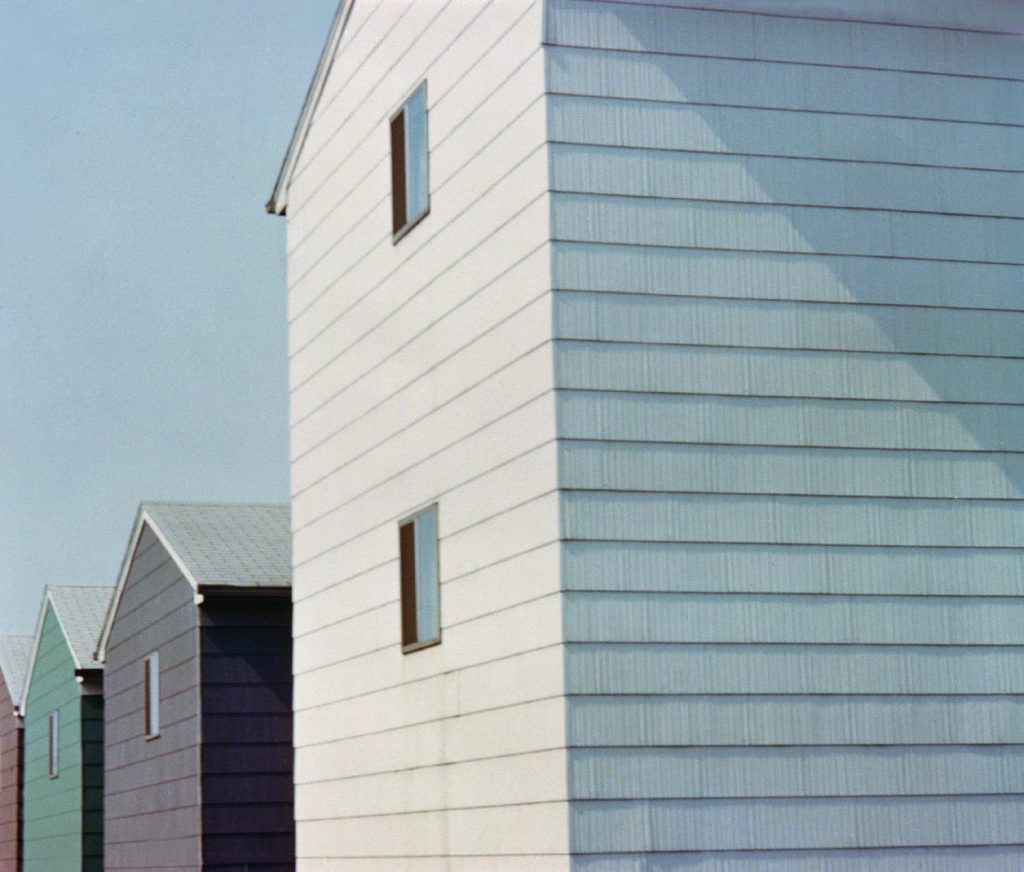Dan Graham VS Denise Scott Brown
"Suburbia Showdown"
In 1965 the United States created the department of Housing and Urban Development (HUD), partly to deal with the biggest urban crisis of American modernity to date. The triumph of the automobile and the new urban infrastructures built after the war trans- formed the anatomy of the landscape and the city, emptying it out and converting it into the last stronghold of poverty. Everyone with the remotest chance would try to buy a house outside the city walls, in the new Eldorado of the suburban expansion.
Today, after almost 50 years, we’ve witnessed a come back to the cities and the failure of Suburbia and the urban sprawl as an economical and sustainable model. Despite efforts to think about solutions, much hasn’t changed yet; especially people’s desire to still want to live there.
Back in the 60s it wasn’t much different really. The staunch criticism of Suburbia that we are familiar with comes from those times. But critiques were somehow less economical and more social. The press speaks about the homogenization of man that would lead to a conformist society through the serial or mass production of housing. But as the sociologist Herbert Gans rightly says “this criticism is a thin veil that disguises an attack on the culture of the working and lower classes, insinuating that mass-produced housing leads to mass produced lives”1. The reality of this new housing, which was cheaper as it was produced in the same way as all other North American industry was that suddenly the most disadvantaged classes could have access to dwellings that the middle and high classes already enjoyed. And this terrified a very influential part of a classist, racist and conservative society. Suburban life predates the urban sprawl in America, it’s a life style well engrained in people’s mind. “America was once a nation of farmers, and love for the earth still courses nostalgically through the veins of even its city dwellers”2.
Two different art and research studies on Suburbia appeared on the 60›s and 70›s that counteracted the establishment’s critique.
Despite sharing a similar perception, they end up being quite different in their nature and their focus. It is extremely interesting looking at them side by side.
We are talking about, on the one hand, the work of the artist Dan Graham ‹Homes for America› 1966. And on the other hand we are referring to the 1970 Yale studio Learning from Levittown by the urbanist and architect Denise Scott Brown and the architect Robert Venturi and their exhibition Signs of Life: Symbols in the American City at the Renwick Gallery in the Smithsonian Institute in 1976.
Both works are fundamental for understanding the change in mentality and attitude that started to take hold at that time. The everyday reality produced by an industrialized consumer society (the advertising machine and the suburban culture of the automobile) and its impact on the environment are strongly attacked or simply ignored by the bourgeois, conservative critique. These two works are perfectly placed to confront head on and translate this reality, without omitting any value or judgments.

Social criticism is one of the key aspects in the work of Venturi Scott Brown, especially influenced by Denise, who in 1959 moved from London to Philadelphia, following a recommendation of the Smithsons, who were doing parallel social studies on the English New Towns built after the war. They recommended her and her then husband Robert Scott Brown to go and study urban planning with Louis Khan at Penn University. Sociologists and urban planners such as Herbert Gans, whom was also her teacher at Penn, but also Melvin Webber and JB Jackson at around the same time, were denouncing this hypocrisy of suburban criticism.
The studio Learning from Levittown whose subtitle is “remedial housing for architects” tries to help the profession to see into the real problem of housing since “to most architects ‘residential work’ means the design of houses and apartments for the rich”. As the authors say “we shall be more interested in what people make of their housing than in what the architects intended them to make of it”3.
The conclusions from the studio are then augmented in the exhibition Signs of Life, where they attempt to survey the pluralist aesthetic of the American City and its suburbs, to understand what the urban landscape means to people, through an analysis of its symbols, their sources and their antecedents. “The ‘ordinary’ symbols and signs of the commercial and residential environment are not acknowledged but are significant in our daily lives.”[...]“In learning to understand our symbols and signs, we come to understand better ourselves and our landscapes“4.
A further aim of the exhibition was to suggest to urban designers, architects and planners, that they open-mindedly study today’s urban landscapes, and specially the symbolic meanings people invest in them. In so doing, these urbanists would learn more than they know about the needs, tastes, and preferences of people whose lives they influence, and particularly about the tastes of groups whose values are different from their own. “Understanding the raison d’être of the physical environment is a necessary prelude to improving it”5.
The material for the show is based partly on graphic material from the student’s research on popular culture and society group values through advertisement, television and printed media and partly based on actual photography. The photographers are Denise Scott Brown who has been photographing social housing and urban culture since the early 50s in South Africa, Europe and the US, the students and two very young artist; Steven Shore and John Baeder who are commissioned to photograph for the home and city sections.
The photography for the Levittown and the American Suburb study tries to catalogue, make typologies and group themes to decipher and understand better the nature of people’s desires, as the exhibition panel title reads: Themes and Ideals of the American Suburb.
Dan Graham’s also sees in New Jersey track houses and Suburbia in general, not the evil, as some might say6, but rather plain reality; an actual and contemporary vision of society. He himself lived until the age of thirteen in government-funded social housing in New Jersey, where he recalls being happier that in the upper-class suburb they moved after that. So he very soon realized the falsity of the whole thing. As he says, “the cliché was to say that tract home suburbs were about alienation. And I didn’t think the lifestyle was about alienation. I just thought of it as representing a fascinating new reality”7. Back in the 60s the conditions of city life were very bad, crime and misery made the suburbs a very nice aspiration for many people. Since the 80s, big cities are experiencing a huge turn around. Thanks to TV series like “Friends” or “Sex in the city” the wealthy suburbanites are coming back to the newly gentrified city centers, making difficult for lower income families to stay or to move in due to the increasing real state prices.

Graham never really liked sociology and was not that interested in people’s specific desires and taste, he was more into the artifacts themselves and their intrinsic language and aesthetic. The interest in serialization is the basis of his research, not as a criticism, quite the contrary, he tries to reveal a new aesthetic system product of its era, very in keeping with the avant-garde artistic movements of the time, whether pop art or minimalism. He was also interested in the new materials that emerged and spread, like plastic. Plastic symbolizes this new fast, cheap, pop and disposable new culture. The houses are sort of disposable, not built to last forever and their visions are like beautiful plastic dreams. “This is about the suburbs at the edge of the city. It’s about the aspirations of people who come from near-slum neighborhoods to recreate a kind of Arcadia in the suburbs”8, Graham says.
Through his photography he captures the generic and systematic nature of these mass housing developments, translating the aspects of a new language consistent with the production methods of the time. His approach is also a poetic one, the poetic flatness and the banal. He was inspired very much by writers like Robert Pinget, who himself was very influenced by Flaubert. A sensibility also shared by Bob and Denise who always refer to their architecture, very consciously, as ‘ugly and ordinary’. Graham is not trying to help or further the tunnel vision of the architecture profession but rather to point out a reality of our landscape tracing its origins into the reality of the mass-produced environment more in accordance with other art investigations, from the serial music of Pierre Boulez to the minimalistic expressionism of his friend Donald Judd “When Judd moved to New Jersey, where I was from, I think its work became very much about its materials: plastics, aluminum, and cheap sidings.”9 And interestingly enough Judd wrote an article about Kansas City and the XIX century city plan. So those artists (Graham, Judd) and urban planner and architects (Scott Brown and Venturi) are really crossing disciplines and helping to formulate the avant-garde language of their time.
As Graham says “all my work is about urban planning”10.
1. The Levittowners, Herbert j. Gans (p.171, Pantheon Books, 1967)
2. Life magazine, 1947
3. On Houses and Housing, Venturi Scott Brown & Associates (AD Academy editions, London 1992) p.51
4. Idem, p.58
5. Idem
6. “the evil made suburbia” says Ole Bouman
in his article ‘Truth or Suburbia’ on Suburbia after the crash, Volume magazine #9 (dec 2006)
7. New Jersey, Dan Graham (Lars Mueller Publishers, 2012) p.108
8. Idem,
9. Idem, p103
10. New Jersey, Dan Graham (p.97, Lars Mueller Publishers, 2012)